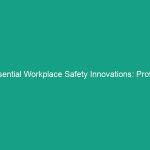Good Morning Team!
Today, we’re going to discuss an important topic that affects not only our Safety but also our productivity during the winter months — the Essential Winter Driving Guidelines. As the weather changes, so do the conditions we face on the roads. Understanding how to navigate these challenges can help us avoid accidents and ensure that we all make it home safely to our loved ones.
Understanding Essential Winter Driving Guidelines
The Essential Winter Driving Guidelines encompass a set of practices aimed at reducing the risks associated with winter weather conditions while driving. These guidelines are crucial for maintaining Safety on the road, especially when temperatures drop, snow falls, or ice forms. Many employees might think they are experienced drivers and can handle winter conditions, but the reality is that even the most skilled drivers can find themselves in precarious situations during winter storms. Therefore, it’s vital to stay informed and prepared.
Key Hazards, Risks, and Safety Considerations
Winter driving poses several Hazards and risks that can lead to accidents. Here are some of the most significant threats:
- Slippery Roads: Ice and snow can create slick surfaces, increasing stopping distances and reducing control.
- Reduced Visibility: Snow, fog, and heavy rain can significantly decrease visibility, making it hard to see other vehicles and road signs.
- Vehicle Malfunction: Cold temperatures can affect battery performance, tire pressure, and other vehicle functions.
- Driver Fatigue: Longer travel times due to adverse conditions can lead to exhaustion, impairing reaction times.
Ignoring these risks can lead to serious consequences, including accidents, injuries, and even fatalities. It’s important to remain vigilant and proactive about winter driving safety.
Best Practices, Procedures, & Actionable Advice
Now that we understand the dangers, let’s look at some essential winter driving tips that everyone should follow:
1. Prepare Your Vehicle
Before hitting the road, ensure that your vehicle is winter-ready:
- Tires: Make sure your tires have adequate tread and are suitable for winter conditions. Consider using winter tires for better traction.
- Fluids: Check your antifreeze levels, windshield washer fluid, and oil to ensure optimal vehicle performance.
- Battery: Cold temperatures can drain batteries. Make sure your battery is fully charged and in good condition.
- Emergency Kit: Keep an emergency kit in your vehicle that includes blankets, a flashlight, food, water, and first-aid supplies.
2. Adjust Your Driving Habits
When driving in winter conditions, adjust your driving style:
- Slow Down: Reduce your speed to accommodate for lower traction and longer stopping distances.
- Increase Following Distance: Maintain a larger gap between your vehicle and the one in front of you to allow for more stopping time.
- Avoid Sudden Movements: Make smooth, gradual turns and stops to prevent skidding.
- Stay Alert: Watch for black ice, especially on bridges and shaded areas of the road.
3. Know What to Do in an Emergency
Even with the best preparations, emergencies can still happen. Here’s what to do:
- If You Skid: Stay calm, ease off the gas, and steer in the direction you want to go.
- In Case of a Breakdown: Pull off the road safely, turn on your hazard lights, and stay in your vehicle if conditions are severe. Call for help and wait for assistance.
- Stuck in Snow: Keep the exhaust pipe clear and try to rock your vehicle back and forth to gain traction.
Regulations, Standards, and Compliance
Complying with safety Regulations not only protects you but also your coworkers. Relevant guidelines may include:
- OSHA Regulations: Ensure that all Safety Measures are in accordance with osha Standards for safe driving.
- Company Policies: Familiarize yourself with any specific winter driving policies your employer has put in place.
- Insurance Requirements: Understand your insurance coverage in relation to winter driving conditions.
Compliance not only keeps us safe but also protects our company from potential liabilities.
Employee Engagement & Discussion
Let’s take a moment to reflect on our own experiences. What safety challenges have you encountered related to winter driving? Have any of you had a close call during winter conditions? Sharing our stories can help us learn from one another and enhance our safety culture.
Conclusion & Key Takeaways
In summary, the Essential Winter Driving Guidelines are vital for ensuring the safety of all employees during the winter months. Remember to prepare your vehicle, adjust your driving habits, and know how to react in an emergency. By applying these practices, we can significantly reduce the risks associated with winter driving.
Thank you for your attention today. Let’s prioritize safety on the roads and make a commitment to look out for one another. Stay safe, stay warm, and let’s make this winter a safe one!


